Finance, Funding, and Decision Making in the Travel and Tourism Sector
VerifiedAdded on 2024/04/25
|30
|4456
|235
Report
AI Summary
This report provides a comprehensive analysis of finance and funding in the travel and tourism sector, emphasizing the importance of cost, volume, and profit (CVP) analysis for management decision-making. It explores various pricing methods and factors influencing profit, such as seasonal, political, and economic changes. The report includes a PowerPoint presentation that explains different types of management accounting information, using Dalata Hotel Group plc as a case study, and assesses the use of this information as a decision-making tool. Furthermore, it interprets the financial statements of Dalata Group Plc for the year ending 2016 and analyzes the sources and distribution of funding for tourism development projects. The report concludes by highlighting the critical role of financial management and accounting in ensuring the sustainable growth and profitability of travel and tourism businesses.
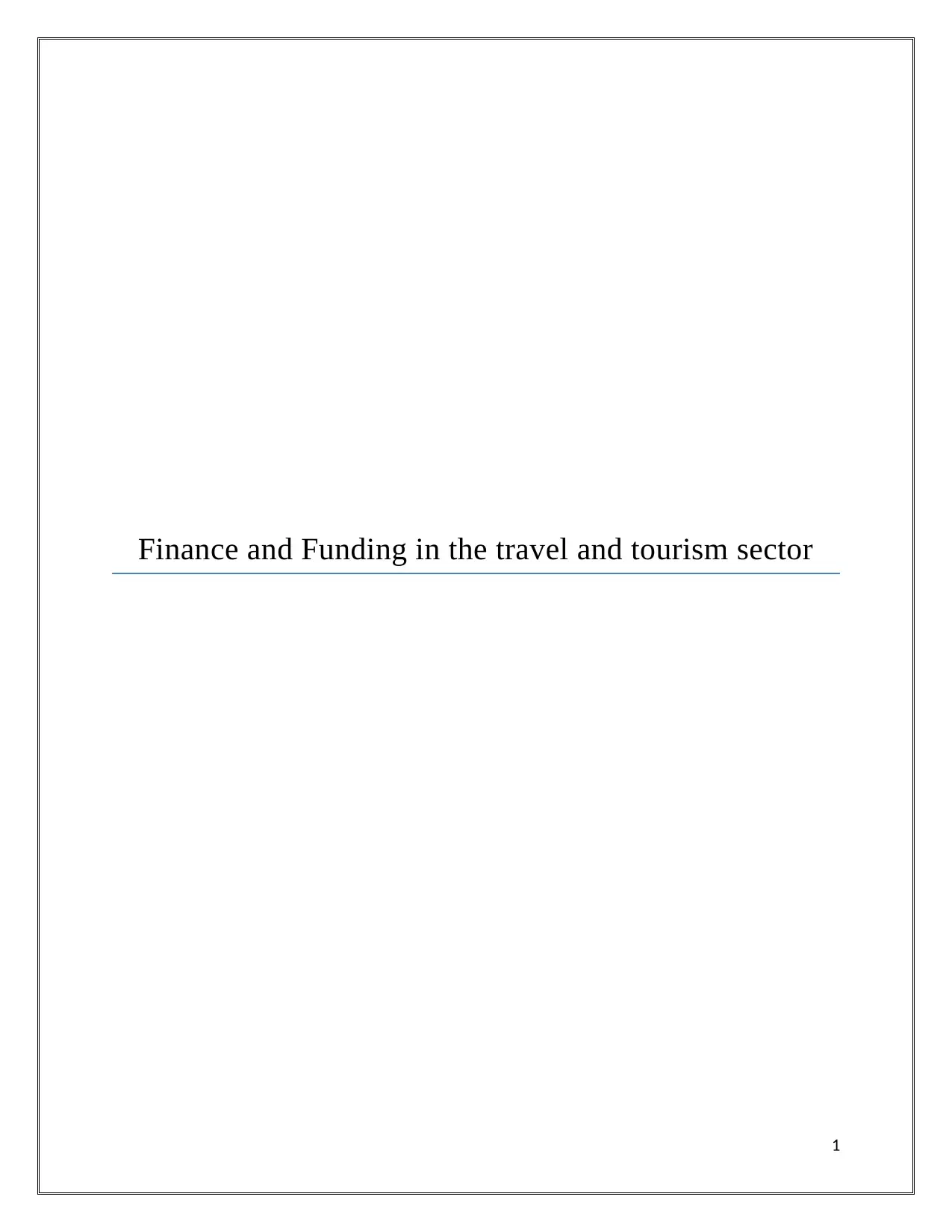
Finance and Funding in the travel and tourism sector
1
1
Paraphrase This Document
Need a fresh take? Get an instant paraphrase of this document with our AI Paraphraser
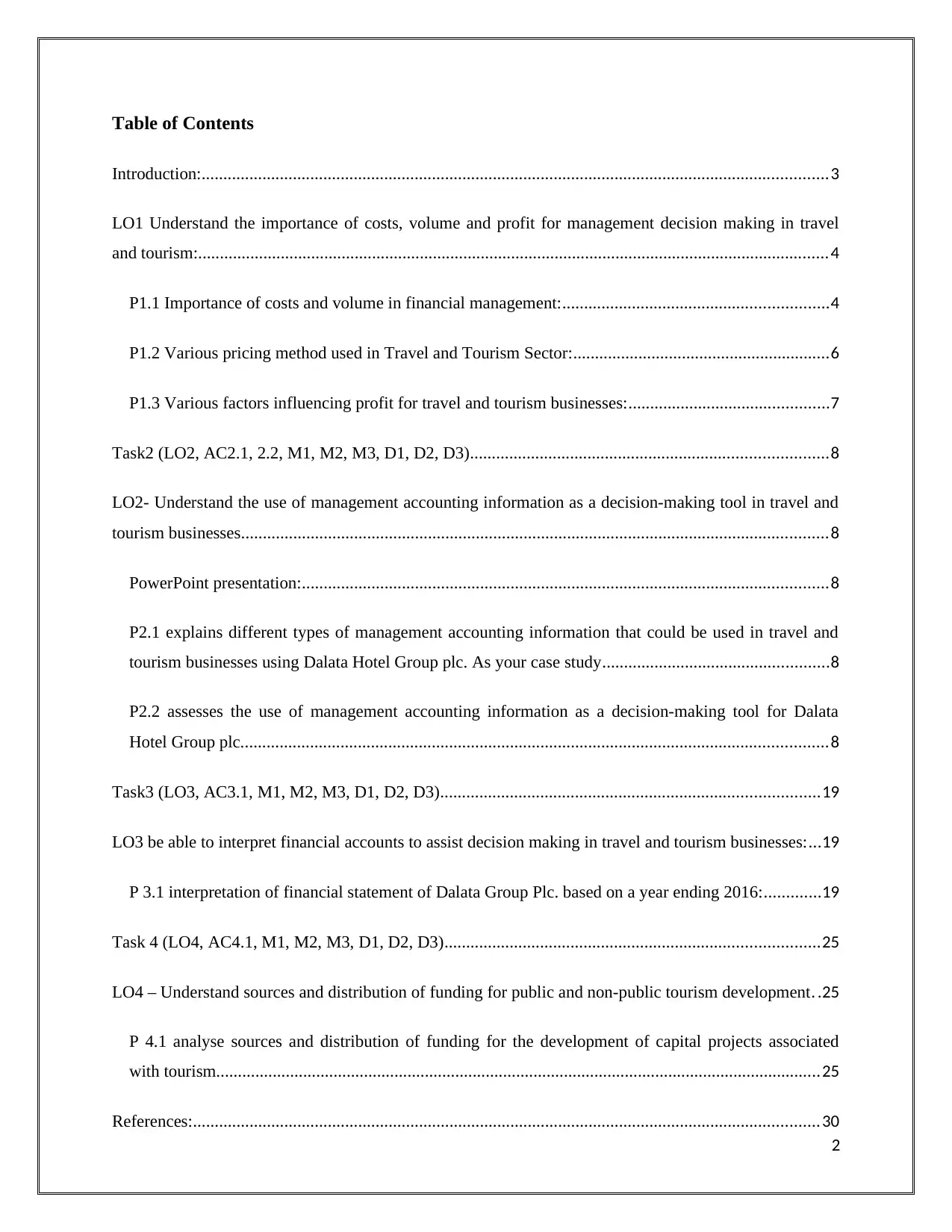
Table of Contents
Introduction:................................................................................................................................................3
LO1 Understand the importance of costs, volume and profit for management decision making in travel
and tourism:.................................................................................................................................................4
P1.1 Importance of costs and volume in financial management:.............................................................4
P1.2 Various pricing method used in Travel and Tourism Sector:...........................................................6
P1.3 Various factors influencing profit for travel and tourism businesses:..............................................7
Task2 (LO2, AC2.1, 2.2, M1, M2, M3, D1, D2, D3)..................................................................................8
LO2- Understand the use of management accounting information as a decision-making tool in travel and
tourism businesses.......................................................................................................................................8
PowerPoint presentation:.........................................................................................................................8
P2.1 explains different types of management accounting information that could be used in travel and
tourism businesses using Dalata Hotel Group plc. As your case study....................................................8
P2.2 assesses the use of management accounting information as a decision-making tool for Dalata
Hotel Group plc.......................................................................................................................................8
Task3 (LO3, AC3.1, M1, M2, M3, D1, D2, D3).......................................................................................19
LO3 be able to interpret financial accounts to assist decision making in travel and tourism businesses:...19
P 3.1 interpretation of financial statement of Dalata Group Plc. based on a year ending 2016:.............19
Task 4 (LO4, AC4.1, M1, M2, M3, D1, D2, D3)......................................................................................25
LO4 – Understand sources and distribution of funding for public and non-public tourism development. .25
P 4.1 analyse sources and distribution of funding for the development of capital projects associated
with tourism...........................................................................................................................................25
References:................................................................................................................................................30
2
Introduction:................................................................................................................................................3
LO1 Understand the importance of costs, volume and profit for management decision making in travel
and tourism:.................................................................................................................................................4
P1.1 Importance of costs and volume in financial management:.............................................................4
P1.2 Various pricing method used in Travel and Tourism Sector:...........................................................6
P1.3 Various factors influencing profit for travel and tourism businesses:..............................................7
Task2 (LO2, AC2.1, 2.2, M1, M2, M3, D1, D2, D3)..................................................................................8
LO2- Understand the use of management accounting information as a decision-making tool in travel and
tourism businesses.......................................................................................................................................8
PowerPoint presentation:.........................................................................................................................8
P2.1 explains different types of management accounting information that could be used in travel and
tourism businesses using Dalata Hotel Group plc. As your case study....................................................8
P2.2 assesses the use of management accounting information as a decision-making tool for Dalata
Hotel Group plc.......................................................................................................................................8
Task3 (LO3, AC3.1, M1, M2, M3, D1, D2, D3).......................................................................................19
LO3 be able to interpret financial accounts to assist decision making in travel and tourism businesses:...19
P 3.1 interpretation of financial statement of Dalata Group Plc. based on a year ending 2016:.............19
Task 4 (LO4, AC4.1, M1, M2, M3, D1, D2, D3)......................................................................................25
LO4 – Understand sources and distribution of funding for public and non-public tourism development. .25
P 4.1 analyse sources and distribution of funding for the development of capital projects associated
with tourism...........................................................................................................................................25
References:................................................................................................................................................30
2
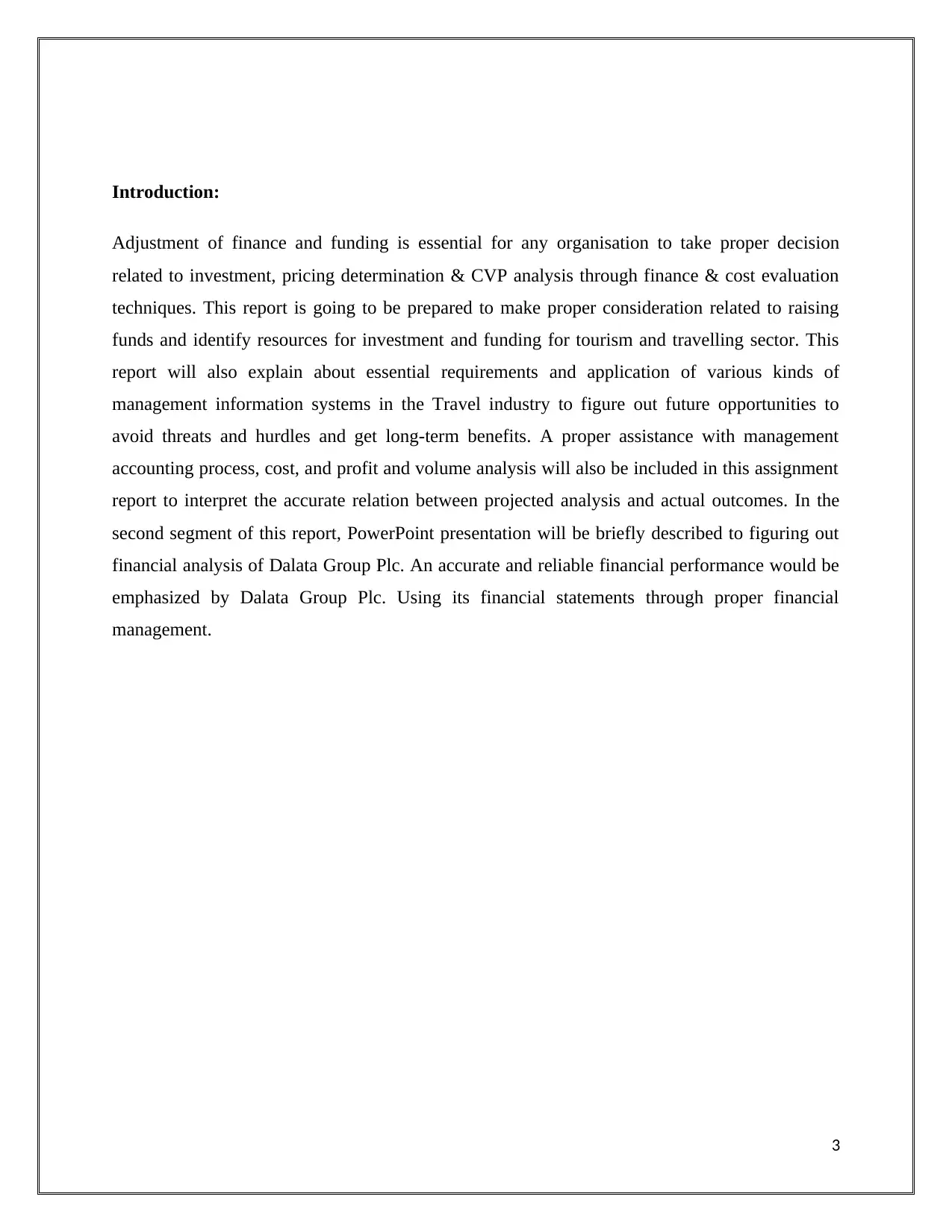
Introduction:
Adjustment of finance and funding is essential for any organisation to take proper decision
related to investment, pricing determination & CVP analysis through finance & cost evaluation
techniques. This report is going to be prepared to make proper consideration related to raising
funds and identify resources for investment and funding for tourism and travelling sector. This
report will also explain about essential requirements and application of various kinds of
management information systems in the Travel industry to figure out future opportunities to
avoid threats and hurdles and get long-term benefits. A proper assistance with management
accounting process, cost, and profit and volume analysis will also be included in this assignment
report to interpret the accurate relation between projected analysis and actual outcomes. In the
second segment of this report, PowerPoint presentation will be briefly described to figuring out
financial analysis of Dalata Group Plc. An accurate and reliable financial performance would be
emphasized by Dalata Group Plc. Using its financial statements through proper financial
management.
3
Adjustment of finance and funding is essential for any organisation to take proper decision
related to investment, pricing determination & CVP analysis through finance & cost evaluation
techniques. This report is going to be prepared to make proper consideration related to raising
funds and identify resources for investment and funding for tourism and travelling sector. This
report will also explain about essential requirements and application of various kinds of
management information systems in the Travel industry to figure out future opportunities to
avoid threats and hurdles and get long-term benefits. A proper assistance with management
accounting process, cost, and profit and volume analysis will also be included in this assignment
report to interpret the accurate relation between projected analysis and actual outcomes. In the
second segment of this report, PowerPoint presentation will be briefly described to figuring out
financial analysis of Dalata Group Plc. An accurate and reliable financial performance would be
emphasized by Dalata Group Plc. Using its financial statements through proper financial
management.
3
⊘ This is a preview!⊘
Do you want full access?
Subscribe today to unlock all pages.

Trusted by 1+ million students worldwide
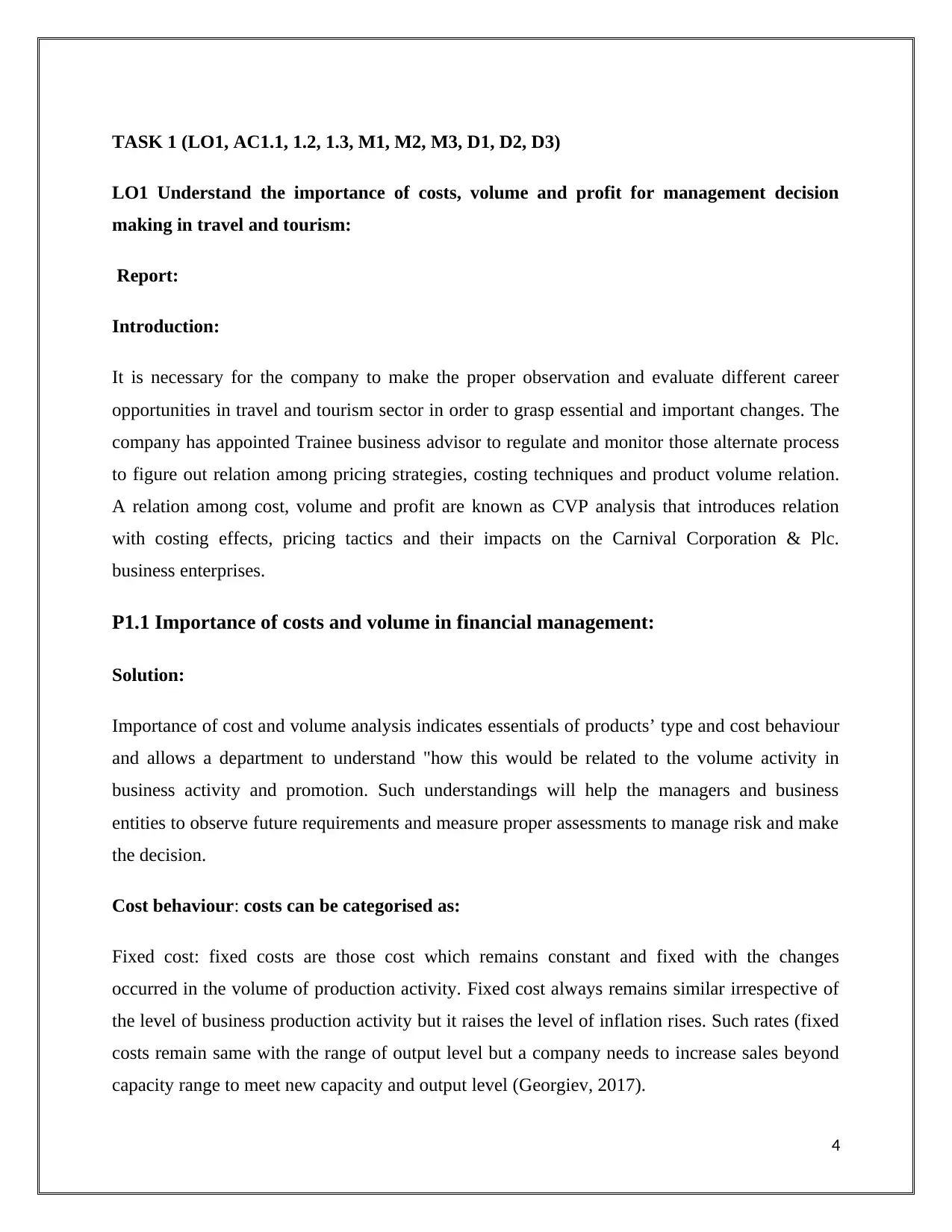
TASK 1 (LO1, AC1.1, 1.2, 1.3, M1, M2, M3, D1, D2, D3)
LO1 Understand the importance of costs, volume and profit for management decision
making in travel and tourism:
Report:
Introduction:
It is necessary for the company to make the proper observation and evaluate different career
opportunities in travel and tourism sector in order to grasp essential and important changes. The
company has appointed Trainee business advisor to regulate and monitor those alternate process
to figure out relation among pricing strategies, costing techniques and product volume relation.
A relation among cost, volume and profit are known as CVP analysis that introduces relation
with costing effects, pricing tactics and their impacts on the Carnival Corporation & Plc.
business enterprises.
P1.1 Importance of costs and volume in financial management:
Solution:
Importance of cost and volume analysis indicates essentials of products’ type and cost behaviour
and allows a department to understand "how this would be related to the volume activity in
business activity and promotion. Such understandings will help the managers and business
entities to observe future requirements and measure proper assessments to manage risk and make
the decision.
Cost behaviour: costs can be categorised as:
Fixed cost: fixed costs are those cost which remains constant and fixed with the changes
occurred in the volume of production activity. Fixed cost always remains similar irrespective of
the level of business production activity but it raises the level of inflation rises. Such rates (fixed
costs remain same with the range of output level but a company needs to increase sales beyond
capacity range to meet new capacity and output level (Georgiev, 2017).
4
LO1 Understand the importance of costs, volume and profit for management decision
making in travel and tourism:
Report:
Introduction:
It is necessary for the company to make the proper observation and evaluate different career
opportunities in travel and tourism sector in order to grasp essential and important changes. The
company has appointed Trainee business advisor to regulate and monitor those alternate process
to figure out relation among pricing strategies, costing techniques and product volume relation.
A relation among cost, volume and profit are known as CVP analysis that introduces relation
with costing effects, pricing tactics and their impacts on the Carnival Corporation & Plc.
business enterprises.
P1.1 Importance of costs and volume in financial management:
Solution:
Importance of cost and volume analysis indicates essentials of products’ type and cost behaviour
and allows a department to understand "how this would be related to the volume activity in
business activity and promotion. Such understandings will help the managers and business
entities to observe future requirements and measure proper assessments to manage risk and make
the decision.
Cost behaviour: costs can be categorised as:
Fixed cost: fixed costs are those cost which remains constant and fixed with the changes
occurred in the volume of production activity. Fixed cost always remains similar irrespective of
the level of business production activity but it raises the level of inflation rises. Such rates (fixed
costs remain same with the range of output level but a company needs to increase sales beyond
capacity range to meet new capacity and output level (Georgiev, 2017).
4
Paraphrase This Document
Need a fresh take? Get an instant paraphrase of this document with our AI Paraphraser
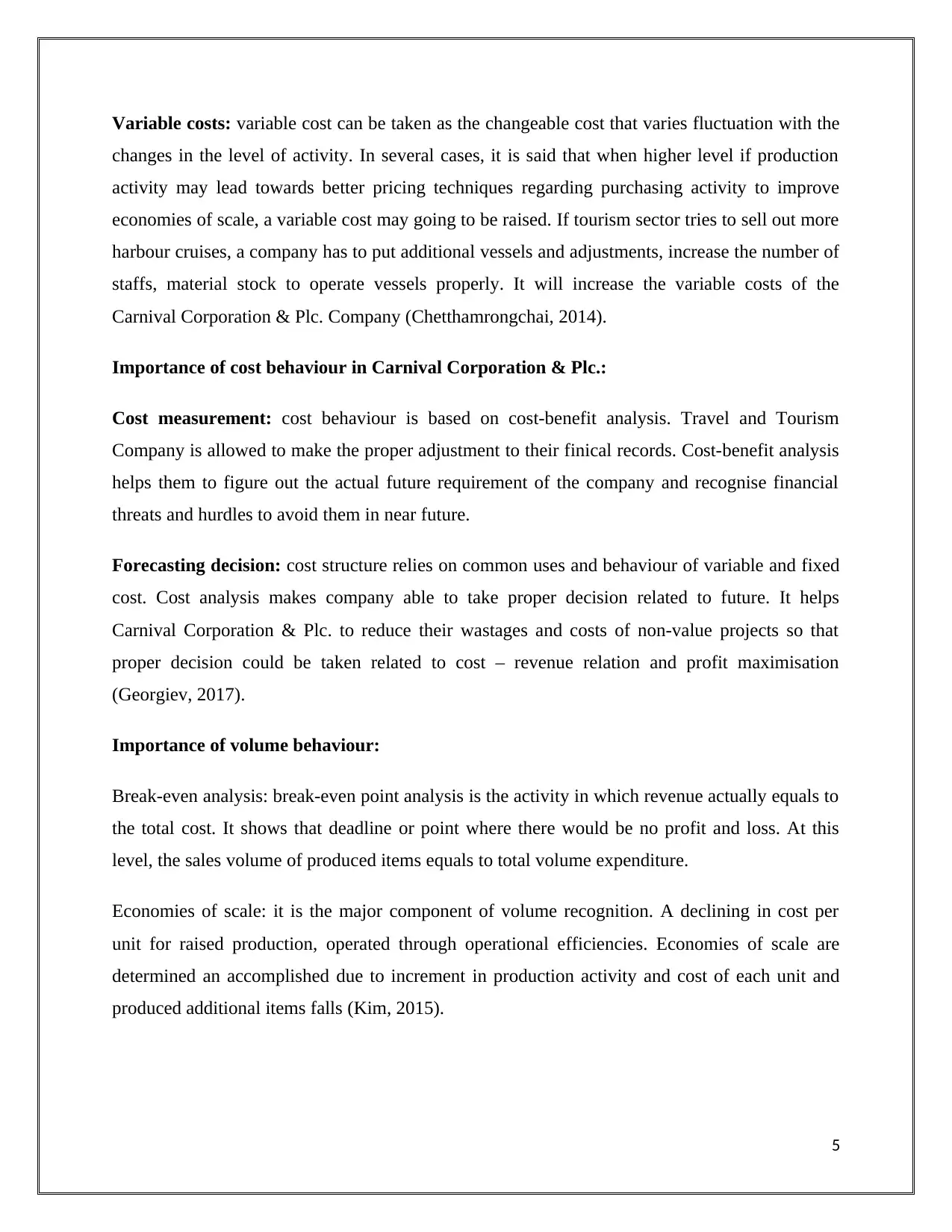
Variable costs: variable cost can be taken as the changeable cost that varies fluctuation with the
changes in the level of activity. In several cases, it is said that when higher level if production
activity may lead towards better pricing techniques regarding purchasing activity to improve
economies of scale, a variable cost may going to be raised. If tourism sector tries to sell out more
harbour cruises, a company has to put additional vessels and adjustments, increase the number of
staffs, material stock to operate vessels properly. It will increase the variable costs of the
Carnival Corporation & Plc. Company (Chetthamrongchai, 2014).
Importance of cost behaviour in Carnival Corporation & Plc.:
Cost measurement: cost behaviour is based on cost-benefit analysis. Travel and Tourism
Company is allowed to make the proper adjustment to their finical records. Cost-benefit analysis
helps them to figure out the actual future requirement of the company and recognise financial
threats and hurdles to avoid them in near future.
Forecasting decision: cost structure relies on common uses and behaviour of variable and fixed
cost. Cost analysis makes company able to take proper decision related to future. It helps
Carnival Corporation & Plc. to reduce their wastages and costs of non-value projects so that
proper decision could be taken related to cost – revenue relation and profit maximisation
(Georgiev, 2017).
Importance of volume behaviour:
Break-even analysis: break-even point analysis is the activity in which revenue actually equals to
the total cost. It shows that deadline or point where there would be no profit and loss. At this
level, the sales volume of produced items equals to total volume expenditure.
Economies of scale: it is the major component of volume recognition. A declining in cost per
unit for raised production, operated through operational efficiencies. Economies of scale are
determined an accomplished due to increment in production activity and cost of each unit and
produced additional items falls (Kim, 2015).
5
changes in the level of activity. In several cases, it is said that when higher level if production
activity may lead towards better pricing techniques regarding purchasing activity to improve
economies of scale, a variable cost may going to be raised. If tourism sector tries to sell out more
harbour cruises, a company has to put additional vessels and adjustments, increase the number of
staffs, material stock to operate vessels properly. It will increase the variable costs of the
Carnival Corporation & Plc. Company (Chetthamrongchai, 2014).
Importance of cost behaviour in Carnival Corporation & Plc.:
Cost measurement: cost behaviour is based on cost-benefit analysis. Travel and Tourism
Company is allowed to make the proper adjustment to their finical records. Cost-benefit analysis
helps them to figure out the actual future requirement of the company and recognise financial
threats and hurdles to avoid them in near future.
Forecasting decision: cost structure relies on common uses and behaviour of variable and fixed
cost. Cost analysis makes company able to take proper decision related to future. It helps
Carnival Corporation & Plc. to reduce their wastages and costs of non-value projects so that
proper decision could be taken related to cost – revenue relation and profit maximisation
(Georgiev, 2017).
Importance of volume behaviour:
Break-even analysis: break-even point analysis is the activity in which revenue actually equals to
the total cost. It shows that deadline or point where there would be no profit and loss. At this
level, the sales volume of produced items equals to total volume expenditure.
Economies of scale: it is the major component of volume recognition. A declining in cost per
unit for raised production, operated through operational efficiencies. Economies of scale are
determined an accomplished due to increment in production activity and cost of each unit and
produced additional items falls (Kim, 2015).
5

P1.2 Various pricing method used in Travel and Tourism Sector:
Proper and effective pricing moves taken by Carnival Corporation & Plc. Travel and Tourism
Company on time could allow them to determine prices and sales profit perfectly. There are
various pricing tactics given below which will help in describing firm’s actual pricing strategy:
1. Penetration method: penetration pricing is the tactics to determine prices at starting and
the low level when business is going to be started. Travel agency tries this method due to
determining the lower competitive level at market value.
2. Pricing skimming: pricing skimming tactic is used to set related prices of the products
and reduce prices with the market demand. In the other words in these tactics prices of
the products are changes based on actual market surplus.
3. Cost-plus pricing: cost-plus pricing is a tool which is used the travel sector to fix and
cover market surplus and more customers. It is basically good for small business
enterprises to make their pricing strategies more competitive.
4. Marginal cost pricing: marginal costing technique is determined as changes in total cost
which are increased with the quantity of additional produced per unit. Such cost is
figured out with the additional production of an item.
6
Proper and effective pricing moves taken by Carnival Corporation & Plc. Travel and Tourism
Company on time could allow them to determine prices and sales profit perfectly. There are
various pricing tactics given below which will help in describing firm’s actual pricing strategy:
1. Penetration method: penetration pricing is the tactics to determine prices at starting and
the low level when business is going to be started. Travel agency tries this method due to
determining the lower competitive level at market value.
2. Pricing skimming: pricing skimming tactic is used to set related prices of the products
and reduce prices with the market demand. In the other words in these tactics prices of
the products are changes based on actual market surplus.
3. Cost-plus pricing: cost-plus pricing is a tool which is used the travel sector to fix and
cover market surplus and more customers. It is basically good for small business
enterprises to make their pricing strategies more competitive.
4. Marginal cost pricing: marginal costing technique is determined as changes in total cost
which are increased with the quantity of additional produced per unit. Such cost is
figured out with the additional production of an item.
6
⊘ This is a preview!⊘
Do you want full access?
Subscribe today to unlock all pages.

Trusted by 1+ million students worldwide
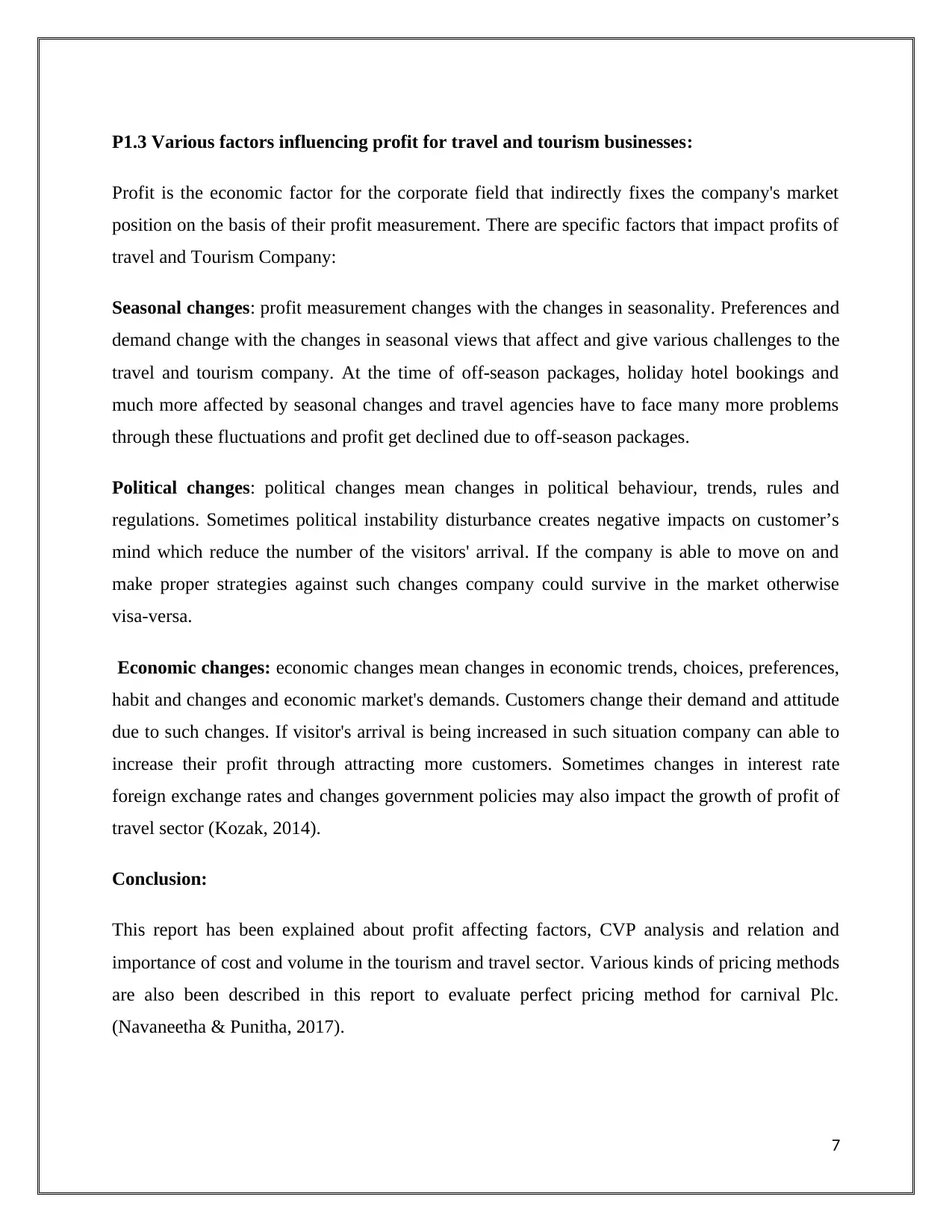
P1.3 Various factors influencing profit for travel and tourism businesses:
Profit is the economic factor for the corporate field that indirectly fixes the company's market
position on the basis of their profit measurement. There are specific factors that impact profits of
travel and Tourism Company:
Seasonal changes: profit measurement changes with the changes in seasonality. Preferences and
demand change with the changes in seasonal views that affect and give various challenges to the
travel and tourism company. At the time of off-season packages, holiday hotel bookings and
much more affected by seasonal changes and travel agencies have to face many more problems
through these fluctuations and profit get declined due to off-season packages.
Political changes: political changes mean changes in political behaviour, trends, rules and
regulations. Sometimes political instability disturbance creates negative impacts on customer’s
mind which reduce the number of the visitors' arrival. If the company is able to move on and
make proper strategies against such changes company could survive in the market otherwise
visa-versa.
Economic changes: economic changes mean changes in economic trends, choices, preferences,
habit and changes and economic market's demands. Customers change their demand and attitude
due to such changes. If visitor's arrival is being increased in such situation company can able to
increase their profit through attracting more customers. Sometimes changes in interest rate
foreign exchange rates and changes government policies may also impact the growth of profit of
travel sector (Kozak, 2014).
Conclusion:
This report has been explained about profit affecting factors, CVP analysis and relation and
importance of cost and volume in the tourism and travel sector. Various kinds of pricing methods
are also been described in this report to evaluate perfect pricing method for carnival Plc.
(Navaneetha & Punitha, 2017).
7
Profit is the economic factor for the corporate field that indirectly fixes the company's market
position on the basis of their profit measurement. There are specific factors that impact profits of
travel and Tourism Company:
Seasonal changes: profit measurement changes with the changes in seasonality. Preferences and
demand change with the changes in seasonal views that affect and give various challenges to the
travel and tourism company. At the time of off-season packages, holiday hotel bookings and
much more affected by seasonal changes and travel agencies have to face many more problems
through these fluctuations and profit get declined due to off-season packages.
Political changes: political changes mean changes in political behaviour, trends, rules and
regulations. Sometimes political instability disturbance creates negative impacts on customer’s
mind which reduce the number of the visitors' arrival. If the company is able to move on and
make proper strategies against such changes company could survive in the market otherwise
visa-versa.
Economic changes: economic changes mean changes in economic trends, choices, preferences,
habit and changes and economic market's demands. Customers change their demand and attitude
due to such changes. If visitor's arrival is being increased in such situation company can able to
increase their profit through attracting more customers. Sometimes changes in interest rate
foreign exchange rates and changes government policies may also impact the growth of profit of
travel sector (Kozak, 2014).
Conclusion:
This report has been explained about profit affecting factors, CVP analysis and relation and
importance of cost and volume in the tourism and travel sector. Various kinds of pricing methods
are also been described in this report to evaluate perfect pricing method for carnival Plc.
(Navaneetha & Punitha, 2017).
7
Paraphrase This Document
Need a fresh take? Get an instant paraphrase of this document with our AI Paraphraser
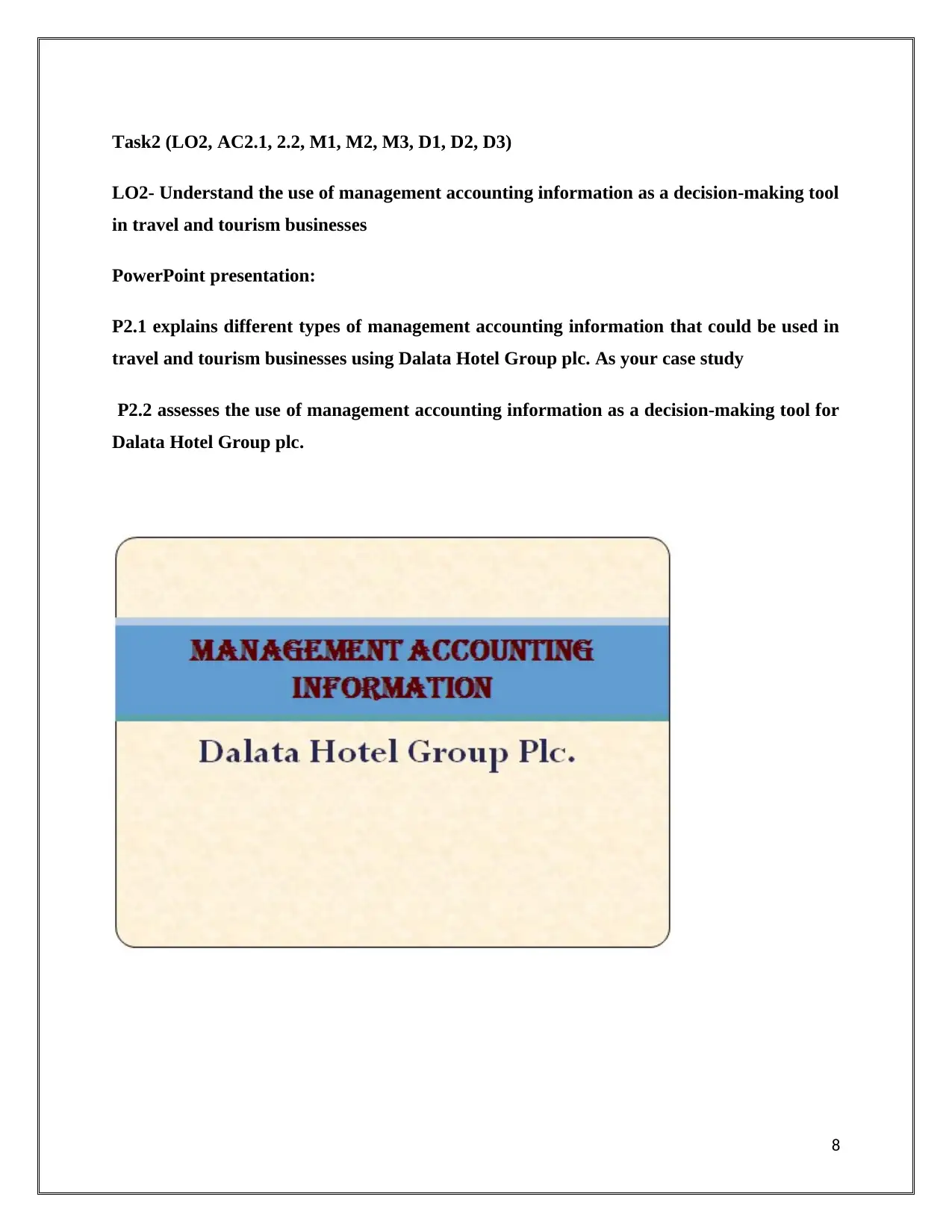
Task2 (LO2, AC2.1, 2.2, M1, M2, M3, D1, D2, D3)
LO2- Understand the use of management accounting information as a decision-making tool
in travel and tourism businesses
PowerPoint presentation:
P2.1 explains different types of management accounting information that could be used in
travel and tourism businesses using Dalata Hotel Group plc. As your case study
P2.2 assesses the use of management accounting information as a decision-making tool for
Dalata Hotel Group plc.
8
LO2- Understand the use of management accounting information as a decision-making tool
in travel and tourism businesses
PowerPoint presentation:
P2.1 explains different types of management accounting information that could be used in
travel and tourism businesses using Dalata Hotel Group plc. As your case study
P2.2 assesses the use of management accounting information as a decision-making tool for
Dalata Hotel Group plc.
8
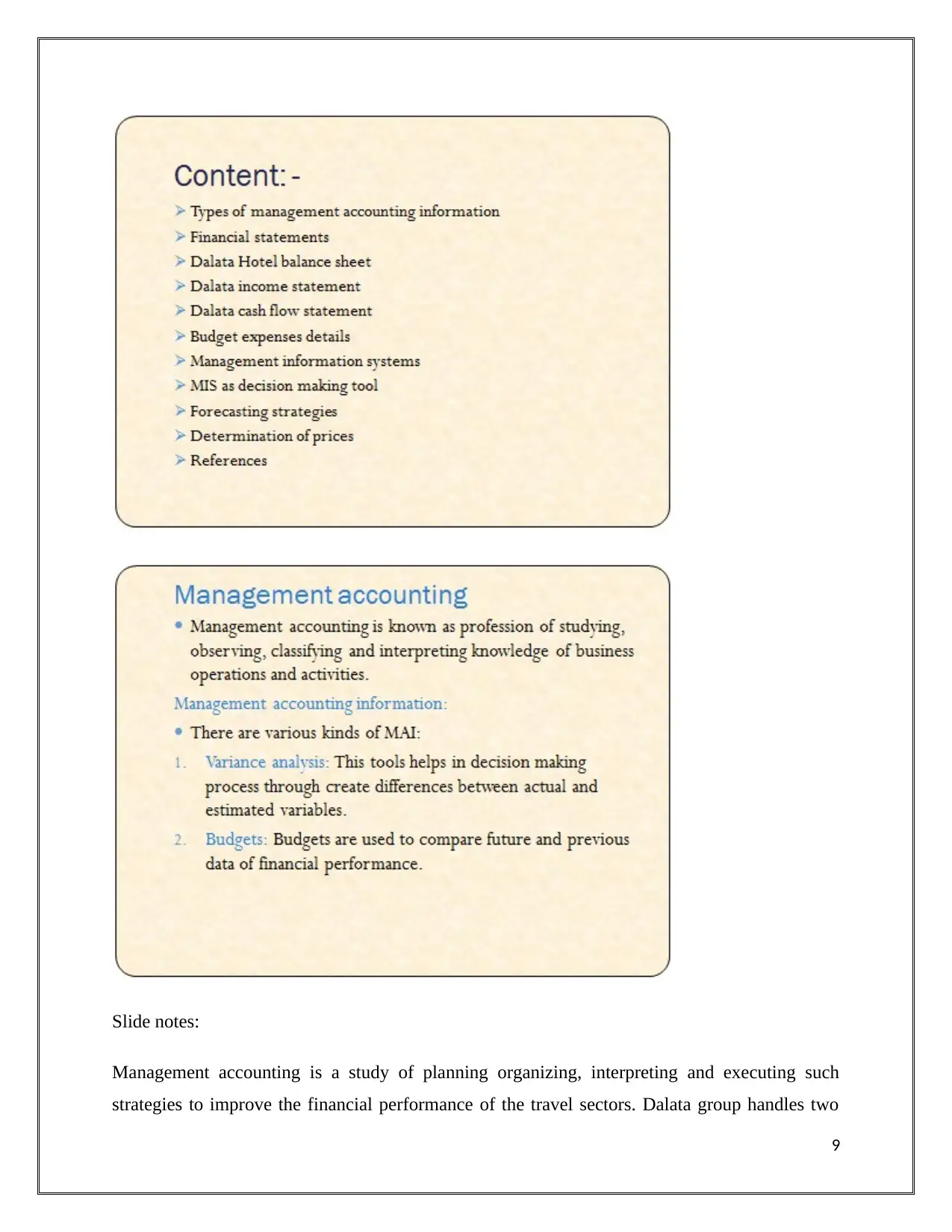
Slide notes:
Management accounting is a study of planning organizing, interpreting and executing such
strategies to improve the financial performance of the travel sectors. Dalata group handles two
9
Management accounting is a study of planning organizing, interpreting and executing such
strategies to improve the financial performance of the travel sectors. Dalata group handles two
9
⊘ This is a preview!⊘
Do you want full access?
Subscribe today to unlock all pages.

Trusted by 1+ million students worldwide
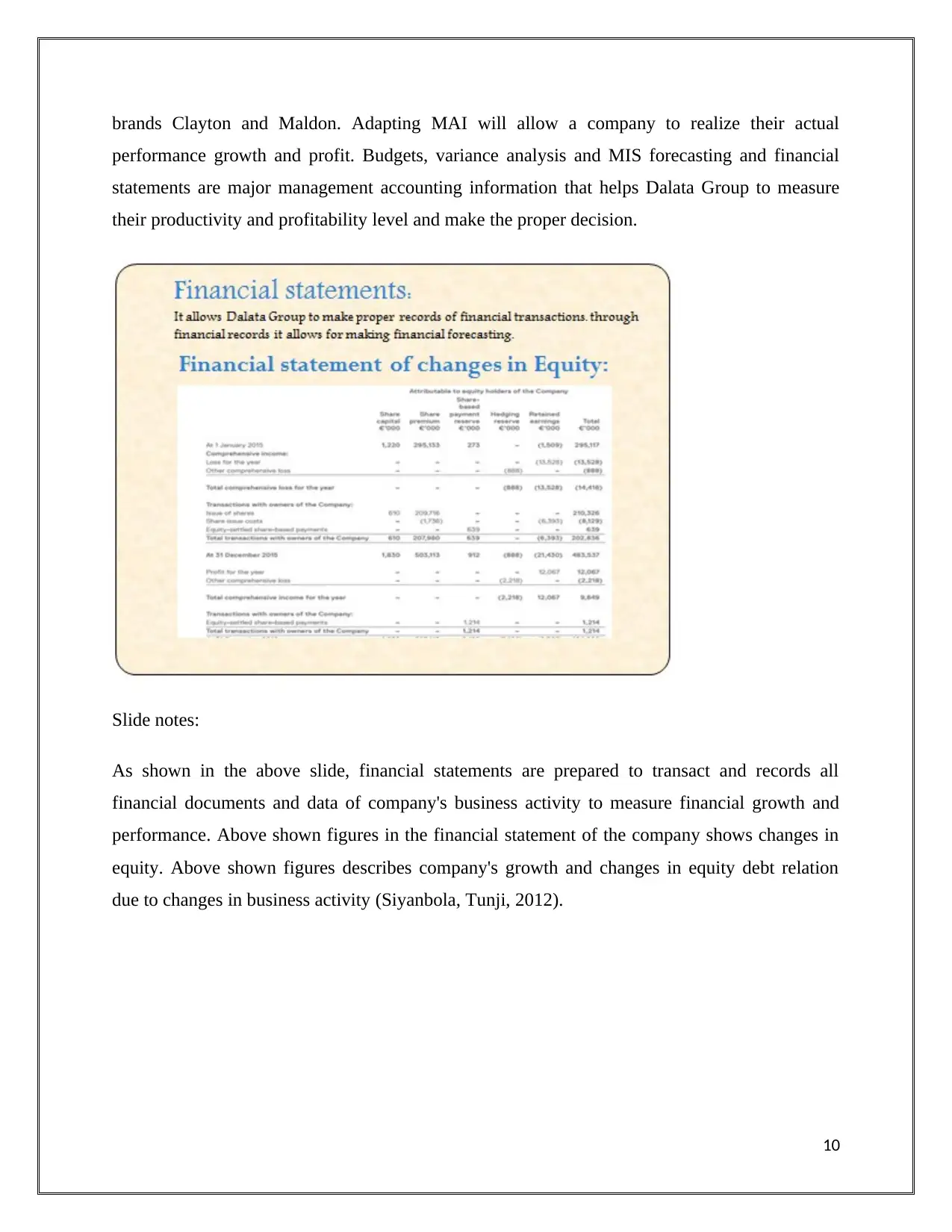
brands Clayton and Maldon. Adapting MAI will allow a company to realize their actual
performance growth and profit. Budgets, variance analysis and MIS forecasting and financial
statements are major management accounting information that helps Dalata Group to measure
their productivity and profitability level and make the proper decision.
Slide notes:
As shown in the above slide, financial statements are prepared to transact and records all
financial documents and data of company's business activity to measure financial growth and
performance. Above shown figures in the financial statement of the company shows changes in
equity. Above shown figures describes company's growth and changes in equity debt relation
due to changes in business activity (Siyanbola, Tunji, 2012).
10
performance growth and profit. Budgets, variance analysis and MIS forecasting and financial
statements are major management accounting information that helps Dalata Group to measure
their productivity and profitability level and make the proper decision.
Slide notes:
As shown in the above slide, financial statements are prepared to transact and records all
financial documents and data of company's business activity to measure financial growth and
performance. Above shown figures in the financial statement of the company shows changes in
equity. Above shown figures describes company's growth and changes in equity debt relation
due to changes in business activity (Siyanbola, Tunji, 2012).
10
Paraphrase This Document
Need a fresh take? Get an instant paraphrase of this document with our AI Paraphraser
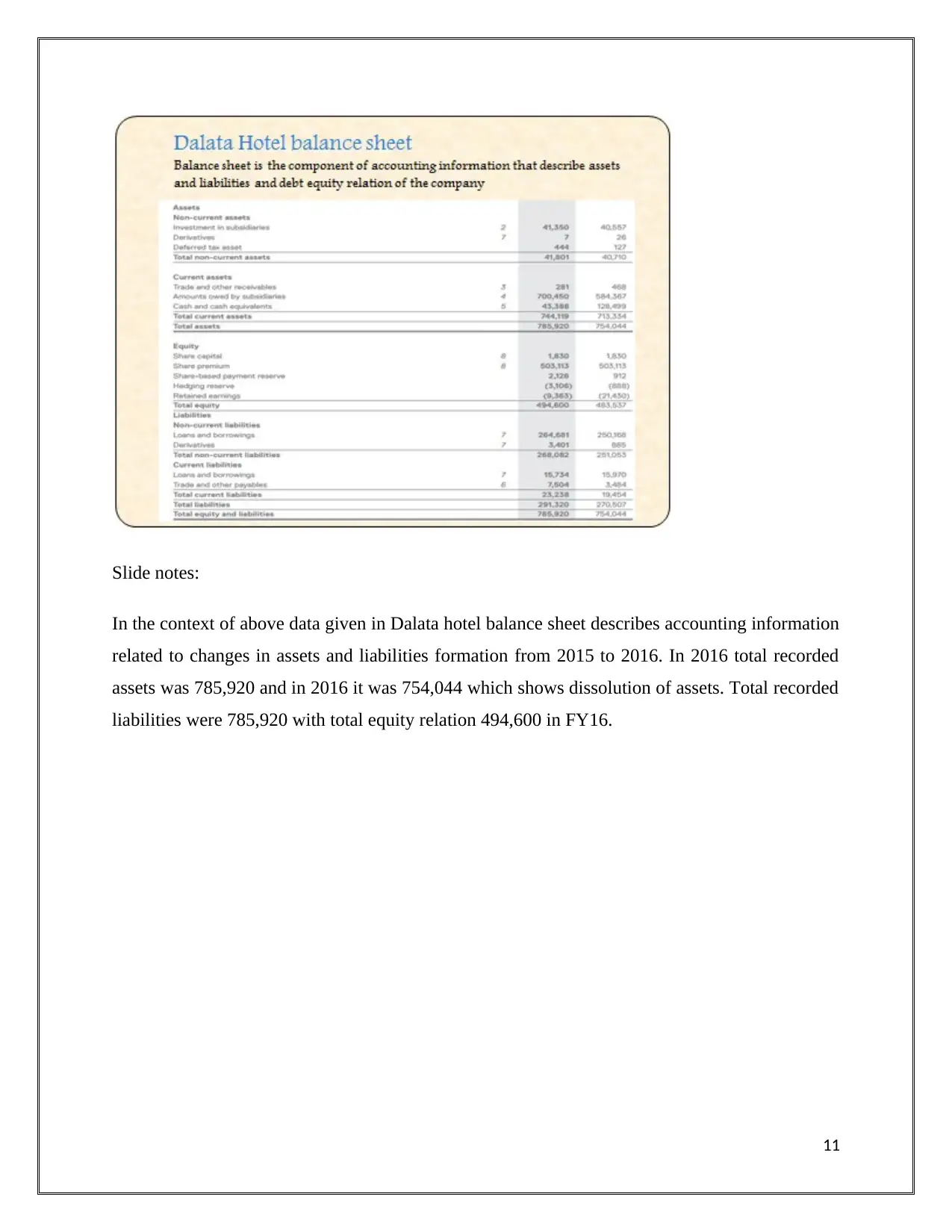
Slide notes:
In the context of above data given in Dalata hotel balance sheet describes accounting information
related to changes in assets and liabilities formation from 2015 to 2016. In 2016 total recorded
assets was 785,920 and in 2016 it was 754,044 which shows dissolution of assets. Total recorded
liabilities were 785,920 with total equity relation 494,600 in FY16.
11
In the context of above data given in Dalata hotel balance sheet describes accounting information
related to changes in assets and liabilities formation from 2015 to 2016. In 2016 total recorded
assets was 785,920 and in 2016 it was 754,044 which shows dissolution of assets. Total recorded
liabilities were 785,920 with total equity relation 494,600 in FY16.
11
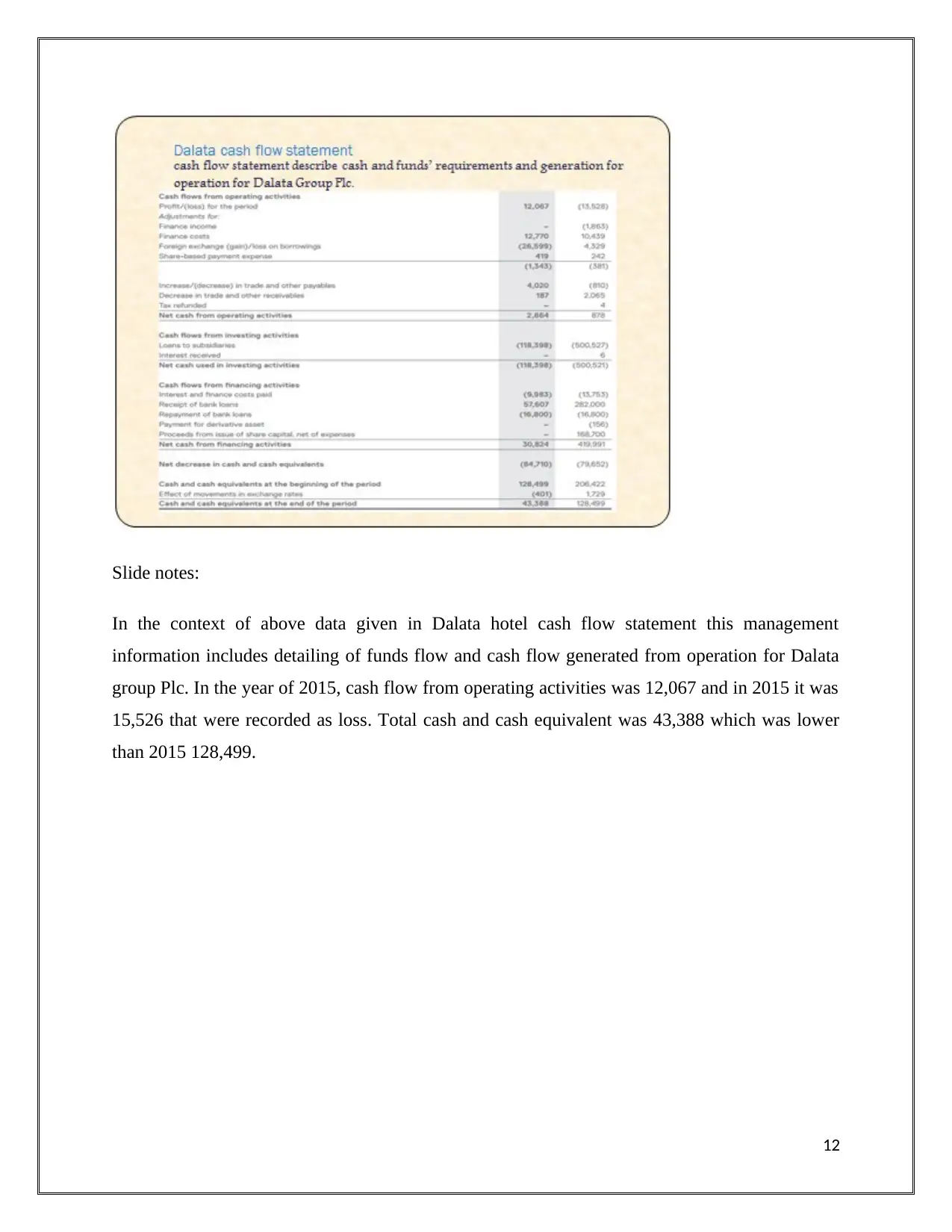
Slide notes:
In the context of above data given in Dalata hotel cash flow statement this management
information includes detailing of funds flow and cash flow generated from operation for Dalata
group Plc. In the year of 2015, cash flow from operating activities was 12,067 and in 2015 it was
15,526 that were recorded as loss. Total cash and cash equivalent was 43,388 which was lower
than 2015 128,499.
12
In the context of above data given in Dalata hotel cash flow statement this management
information includes detailing of funds flow and cash flow generated from operation for Dalata
group Plc. In the year of 2015, cash flow from operating activities was 12,067 and in 2015 it was
15,526 that were recorded as loss. Total cash and cash equivalent was 43,388 which was lower
than 2015 128,499.
12
⊘ This is a preview!⊘
Do you want full access?
Subscribe today to unlock all pages.

Trusted by 1+ million students worldwide
1 out of 30
Related Documents
Your All-in-One AI-Powered Toolkit for Academic Success.
+13062052269
info@desklib.com
Available 24*7 on WhatsApp / Email
![[object Object]](/_next/static/media/star-bottom.7253800d.svg)
Unlock your academic potential
Copyright © 2020–2025 A2Z Services. All Rights Reserved. Developed and managed by ZUCOL.




